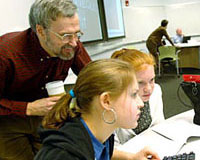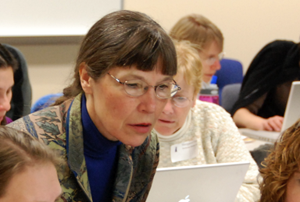Introduction
In the field of biology, freely available software packages allow students to explore molecular structure in 3D. However, few present the materials in a format clear enough to use outside the classroom or in self-guided study. In addition, most 3D software packages neglect to portray the four-fold structure of proteins, a critical component to understanding the complexities of change and disease.
The Educational Need
Prof Graham Walker set about to fill this gap for his undergraduate biology students: “I wanted to create a viewer that presented structures and functions in the same way we presented them in class, was usable outside the class (without staff supervision) and allowed students many of the freedoms and exploratory options of research-level PDB viewers."

In order to bring this tool to his students, Walker envisioned an “educationally friendly interface” that would function as an overlay to a professional level 3D viewer. However, after extensive and unsuccessful work with two developers of professional level 3D viewers, it became apparent it would be necessary to build his own.
The Collaboration
Brandeis professor Melissa Kosinski-Collins and MIT professor John Belcher had similar pedagogical interests to Walker. Kosinski-Collins' research was on concept-based teaching in biology. Belcher had led a team in the development open-source educational software tools. Kosinski-Collins and Belcher had been meeting with Walker in his HHMI (Howard Hughes Medical Institute) Education Group seminar to explore possible directions for the 3D viewer. Phil Long of OEIT also became aware of Walker’s work and realized there was potential for collaboration. Long suggested Chuck Shubert of OEIT attend the HHMI meetings. Shubert, software architect and program leader with OEIT’s Software Tools for Academics and Researchers (STAR) group, was excited to learn about the 3D viewer project because it was in complete alignment with one of OEIT's core mandates, namely to bring research tools to teaching and learning. Shubert proposed that his team build the 3D viewer, using the TEALsim computing environment, originally developed by John Belcher. This approach would leverage Belcher’s previous developmental work and – because TEALsim is platform independent – would use a computing environment that ran on virtually any computer.
Chuck Shubert and CECI affiliate Mike Danziger converted data files from the Protein Data Bank (PDB) into a 3D rendering that was color-coded to indicate different elements. They then enhanced the rendering with a user interface to the PDB, and the application StarBiochem was born.
StarBiochem
StarBiochem allows users to select elements of a molecule and shrink them or make them less visible. By reducing the visibility of some elements, others come to the foreground, and internal structures begin to appear. The molecular image can also be rotated, offering alternate views.
Click below for a demonstration.
Walker: “StarBiochem has one particular design feature critical to its success in the context of biology education. In class, we invariably introduce protein structure as a build-up of primary, to secondary, to tertiary, to quaternary structures. While most software packages avoid mention of these levels altogether, StarBiochem can open any protein PDB coordinate file and categorize it into its different structural levels. This allows the student to conceptually analyze the 3D structure, and by looking at the primary structural changes in the molecule, the student can determine at which structural level the disease manifests itself. “
User Response
 The level of interest and response to StarBiochem has been overwhelming. 800 students in MIT’s Introduction to Biology course used StarBiochem during the 2006-2007 academic year. In September ‘07 alone over 700 users accessed it. In AY 2007-08 approximately 1000 MIT students used the program. Students in biology courses at Brandeis and Stanford use the software as well as high school students participating the Broad Institute High School outreach program. Because StarBiochem is freely available, unaffiliated students and researchers can use it and it is expected that high school usage will also grow. Even more remarkable, no bugs have been reported and none of the users received training on how to use the software.
The level of interest and response to StarBiochem has been overwhelming. 800 students in MIT’s Introduction to Biology course used StarBiochem during the 2006-2007 academic year. In September ‘07 alone over 700 users accessed it. In AY 2007-08 approximately 1000 MIT students used the program. Students in biology courses at Brandeis and Stanford use the software as well as high school students participating the Broad Institute High School outreach program. Because StarBiochem is freely available, unaffiliated students and researchers can use it and it is expected that high school usage will also grow. Even more remarkable, no bugs have been reported and none of the users received training on how to use the software.
Next Steps
StarBiochem has also prompted exploration into new areas. Walker: “Recently, we have begun to push the boundaries of undergraduate understanding of the protein structure-function relationship... this fall (2008), introductory biology students at Brandeis University are being asked to use StarBiochem to explore the structure of human eye lens protein. They are analyzing the shape and chemistry of the molecule in 3D and then select an amino acid they feel is important to the folding and structure of this protein based solely on their 3D investigation.”
Another exciting development is the use of the StarBiochem development paradigm to prototype visualization software for hydrology and genetics. In June 2008 these new initiatives, jointly led by OEIT and MIT’s Biology department, found funding from the Davis Foundation.
In the light of past successes and new directions, John Belcher’s 2006 comment seems apt: “StarBiochem is the most successful educational technology that I have been associated with at MIT.”
